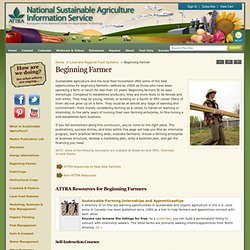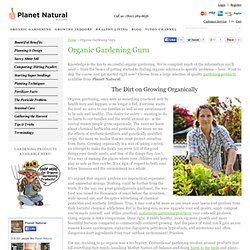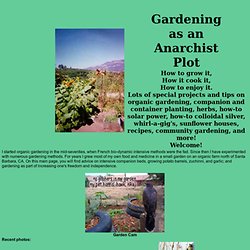

Robert
.
Master Gardeners of Santa Clara County. Beginning Farmer: ATTRA - National Sustainable Agriculture Information Service. Home >Local and Regional Food Systems > Beginning Farmer Sustainable agriculture and the local food movement offer some of the best opportunities for beginning farmers—defined by USDA as those who have been operating a farm or ranch for less than 10 years.

Beginning farmers fit no easy stereotype. Compared to established producers, they are more likely to be female and non-white. They may be young, retired, or working on a fourth or fifth career. Many of them did not grow up on a farm. If you fall somewhere along this continuum, you've come to the right place. NOTE: Some of the following documents are available as Adobe Acrobat PDFs. ATTRA Resources to Help New Farmers Non-ATTRA Resources ATTRA Resources for Beginning Farmers Self-Instruction Courses Beyond Text Instructional Materials Are you a beginning farmer? ATTRA Publications. Tips and Advice on Outdoor Gardening, Flower Gardens, Plants, & Seeds - Dave's Garden. Organic Gardening Guru - How to Grow Organically. Knowledge is the key to successful organic gardening.

We’ve compiled much of the information you’ll need – from the basics of getting started to finding organic solutions to specific problems – here. Want to skip the course and get started right now? Choose from a large selection of quality gardening products available from Planet Natural. Gardening as an Anarchist Plot. Do-it-Yourself Absinthe.

A companion bed of herbs and vegetables: I planted a thick bed of herbs and vegetables. After selecting the main ones I wanted, I added a few plants purely for their value as companion plants: e.g., horehound for the tomatoes and yarrow for the herbs. Then I sorted everything out according to likes and dislikes, e.g., tomatoes like both dill and carrots, but dill and carrots dislike each other, so the carrots went on one edge and side of the bed; the dill went on the other. Then I arranged things according to soil strata, e.g., root crops mixed with bushy herbs; tallest plants at the back. and kohlrabi thrown in for comic relief. Companion planting also brings out the best in some plants, e.g., sage and peppermint, which I grow for medicinal use, also drive away cabbage butterflies and carrot flies.
Chelsea Green: The Politics and Practice of Sustainable Living. National Gardening Association. Go Organic - Organic Gardening and Garden Tips. Using pesticides and herbicides need not be synonymous with toxic chemicals that harm our health and our gardens.

There are many natural techniques, home-made recipes and commercial organic sprays that are effective without harming the surrounding environment. The problem with pesticide sprays, besides introducing yet more chemicals into our system, is they often kill the “good” insects that would otherwise help us combat problem pests. The spray that kills aphids could also kill dragonflies, butterflies and honeybees. In fact, 95% of all insects in your garden are either harmless or actually help your plants. With that in mind, spot-treating is much better than going over your entire garden with a spray.
If your home needs serious pest treatment and you would like to stay away from pesticides, you can learn how to control termites along with other general tips on keeping insect populations low. Natural Pesticides. Vegetable Diseases Fact Sheets listed by Crop. Click on the name of the vegetable to get a listing of Fact Sheets and Information Bulletins relating to that specific crop.

Asparagus | Beans | Beet | Broccoli | Brussels Sprouts | Cabbage | Carrot | Cauliflower | How to Can, Freeze, Dry and Preserve Any Fruit or Vegetable at Home. Home canning, freezing and preserving, whether it is jam, salsa, applesauce, apple butter, pickles or whatever, is easy; with these simple, fully illustrated directions with detailed tips and tricks.

Fotogalerie. The 5 Best Culinary Herbs You’ve Never Heard Of. Culinary Herbs - A complete guide for Growing and Using Herbs in Cooking. Culinary Herb Descriptions - A pictorial guide for Common Culinary Herbs. Welcome to Oregon Tilth — Oregon Tilth. Gardening How-To Articles and Advice from Gardener's Supply Company. Fine Gardening: Expert garden plant advice, tips, and ideas from Fine Gardening magazine, including design, care, and how-to garden techniques. Bringing the Chef's Garden Farm to You. ‘Paris Market’ Carrots are Round Delights. Carrots (Daucus carota) are popular cool-season, root vegetables to grow in home gardens.

But the longer varieties – which can grow up to 8 inches long - are hard to grow in heavy, clay soil conditions. If you have clay soil, consider ‘Paris Market’ (aka ‘Tonda di Parigi’) carrots, which I discovered last year. The round French heirlooms from the 19th century grow only 1 to 2 inches in diameter. These carrots thrive in containers and can handle clay soil (although you’ll want to add organic matter like compost regularly to improve your garden soil quality.) Shown are some carrots we harvested in fall 2010. This early variety ripens in 50 to 68 days. Growing Carrots: This root vegetable is difficult to transplant, so sow carrot seeds directly into your garden about 3 to 4 weeks before the last spring frost … or as soon as soil can be worked. Carrots prefer full sun, but tolerate light shade. As the seeds are tiny, they can be hard to handle.
Potato Gardens Across the USA.